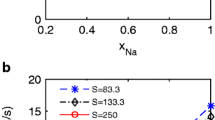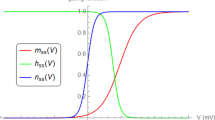Abstract
Asymmetric displacement currents, Ig, were measured in squid axons at different hydrostatic pressures, P, up to 60 MPa. Potassium and sodium currents were abolished by intracellular Cs+ and TEA+, by extracellular Tetrodotoxin (TTX), and by Na+ substitution with Tris+. The time course of Ig became progressively slower with increasing pressure, and the amplitude decreased. With appropriate scaling in time and amplitude, Ig records at any given P could be made to superimpose very well with those obtained at atmospheric pressure. The same scaling factors yielded a good superposition of all records obtained for voltage steps to membrane potentials in the range-30 to +42 mV. The ratio between the amplitude and time factors was larger than unity and increased with P, indicating a progressive decrease (up to 35% at 60 MPa) of the total charge displaced, Q, with no significant change in its voltage dependence. The time-scaling factor increased exponentially with P, as expected if all the steps involved in the opening of a sodium channel, and producing a major charge redistribution, have the same activation volume, ΔV ≠g ∼17 cm3/mol. This value is roughly one-half of that characterizing the pressure dependence of sodium current activation, suggesting that some late, rate-limiting step in the opening of sodium channels has a large activation volume without being accompanied by an easily detected charge movement.
Part of the decrease of Q with pressure could be attributed to an increase in sodium inactivation. However, we cannot exclude the possibility that there is a reversible reduction in the number of fast activating sodium channels, similar to the phenomenon that has been reported to occur at low temperatures (Matteson and Armstrong 1982).
Similar content being viewed by others
References
Almers W, Armstrong CM (1980) Survival of K permeability and gating currents in squid axons perfused with K-free media. J Gen Physiol 75: 61–78
Armstrong CM (1981) Sodium channels and gating currents. Physiol Rev 61: 644–683
Armstrong CM, Bezanilla F (1973) Currents related to the movement of the gating particles of the sodium channels. Nature 242: 459–461
Armstrong CM, Bezanilla F (1977) Inactivation of the sodium channel. II. Gating current experiments. J Gen Physiol 70: 567–590
Armstrong CM, Croop RS (1982) Simulation of Na channel inactivation by thiazin dyes. J Gen Physiol 80: 641–662
Armstrong CM, Gilly WF (1979) Fast and slow steps in the activation of Na channels. J Gen Physiol 74: 691–711
Bennett PB (1975) The high pressure nervous syndrome. In: Bennet PB, Elliot DH (eds) The physiology and medicine of diving and compressed air work. Bailliere Tindall, London, pp 248–263
Benz R, Conti F (1981) Structure of the squid axon membrane as derived from charge-pulse relaxation studies in the presence of absorbed lipophilic ions. J Membrane Biol 59: 91–104
Benz R, Conti F, Fioravanti R (1984) Extrinsic charge movement in the squid axon membrane: effect of pressure and temperature. Eur Biophys J 11: 51–59
Bezanilla F, Taylor RE (1978) Temperature effects on gating currents, in the squid giant axon. Biophys J 23: 479–484
Bezanilla F, White MM, Taylor RE (1982) Gating currents associated with potassium channel activation. Nature 296: 657–659
Brauer RW (1975) The high pressure nervous syndrome: animals. In: Bennett PB, Elliott DH (eds) The physiology and medicine of diving and compressed air work. Bailliere Tindall, London, pp 231–247
Chandler WK, Meves H (1965) Voltage clamp experiments on internally perfused giant axons. J Physiol (London) 180: 799–820
Chandler WK, Meves H (1970) Sodium and potassium currents in squid axons perfused with fluoride solutions. J Physiol (London) 211: 623–652
Conti F, Palmieri G (1968) Nerve fiber behavior in heavy water under voltage-clamp. Biophysik 5: 71–77
Conti F, Fioravanti R, Segal JR, Stühmer W (1982a) Pressure dependence of the sodium current of squid giant axon. J Membr Biol 69: 23–34
Conti F, Fioravanti R, Segal JR, Stühmer W (1982b) Pressure dependence of the potassium currents of squid giant axon. J Membr Biol 69: 35–40
Ebbecke V, Schaefer H (1935) Über den Einfluß hoher Drucke auf den Aktionsstrom von Muskeln und Nerven. Pfluegers Arch Ges Physiol 236: 678–692
French RJ, Horn R (1983) Sodium channel gating: models, mimics, and modifiers. Annu Rev Biophys Bioeng 12: 319–356
Gilly WF, Armstrong CM (1980) Gating current and potassium channels in the giant axon of the squid. Biophys J 29: 485–492
Greeff NG, Keynes RD, van Helden DF (1982) Fractionation of the asymmetry current in the squid giant axon into inactivating and non-inactivating components. Proc R Soc Lond B 215: 375–389
Grundfest H (1936) Effects of hydrostatic pressure upon the excitability, the recovery and the potential sequence of frog nerve. Cold Spring Harbor Symp Quant Biol 5: 179–187
Harper AA, Macdonald AG, Wann KT (1981) The action of high hydrostatic pressure on the membrane currents of Helix neurones. J Physiol (Lond) 311: 325–339
Henderson JV, Gilbert DL (1975) Slowing of ionic currents in the voltage clamped squid axon by helium pressure. Nature 258: 351–352
Hodgkin AL, Huxley AF (1952) A quantitative description of membrane current and its application to conduction and excitation in nerve. J Physiol (London) 177: 500–554
Johnson FJ, Eyring H, Stover B (1974) The theory of rate processes in biology and medicine. Wiley, New York
Keynes RD (1983) Voltage-gated ion channels in the nerve membrane. Proc R Soc Lond 220: 1–30
Kimura JE, Meves H (1979) The effect of temperature on the asymmetrical charge movement in squid giant axons. J Physiol (London) 289: 479–500
Macdonald AG (1984) The effects of pressure on the molecular structure and physiological functions of cell membranes. Philos Trans R Soc Lond B 304: 47–68
Matteson DR, Armstrong CM (1982) Evidence for a population of sleepy sodium channels in squid axon at low temperature. J Gen Physiol 79: 739–758
Meves H (1974) The effect of holding potential on the asymmetry currents in squid giant axons. J Physiol 243: 847–867
Moore JW, Cole KS (1963) Voltage-clamp technique. In: Nastuk WL (ed) Physical techniques in biological research, Vol 6: Electrophysiological methods, part B. Academic Press, New York
Rojas E, Ehrenstein G (1975) Voltage clamp experiments with potassium as the only internal and external cation. J Cell Comp Physiol 66: 71–77
Rudy B (1978) Slow inactivation of the sodium conductance in squid giant axons. Pronase resistance. J Physiol 283: 1–21
Schauf CL, Bullock JO (1979) Modifications of sodium channel gating in Muxicola giant axons by deuterium oxide, temperature, and internal cations. Biophys J 27: 193–208
Spyropoulos CS (1957a) Responses of single nerve fibers at different hydrostatic pressures. Am J Physiol 189: 214–218
Spyropoulos CS (1957b) The effects of hydrostatic pressure upon the normal and narcotizated nerve fiber. J Gen Physiol 40: 849–857
Stühmer W, Conti F, Inoue I (1983) The effect of hydrostatic pressure on Na gating currents of squid giant axons. Biophys J 41: 54a
Tasaki I, Watanabe A, Takenaka T (1962) Resting and action potential of intracellularly perfused squid giant axon. Proc Natl Acad Sci USA 48: 1177–1181
Wann KT, Macdonald AG (1980) The effects of pressure on excitable cells. Comp Biochem Physiol 66A: 1–12
Author information
Authors and Affiliations
Rights and permissions
About this article
Cite this article
Conti, F., Inoue, I., Kukita, F. et al. Pressure dependence of sodium gating currents in the squid giant axon. Eur Biophys J 11, 137–147 (1984). https://doi.org/10.1007/BF00276629
Received:
Accepted:
Issue Date:
DOI: https://doi.org/10.1007/BF00276629




